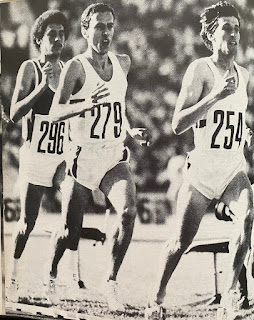Nothing against Nick Willis, the runner I think who has the best running form belongs to Sebastian Coe (pictured below). If you are old enough to remember Seb, he's the only runner to win back to back Olympic 1500m races (in 1980 and 1984). Also a former world record holder for the 800m, 1000m, 1500m and the mile. My friend Nai Min even named his older boy after Coe.
Seb Coe was much faster in his prime and also finished 2nd in the 800m at the Olympics twice. But Seb never did run 19 consecutive years of sub-4 min miles.
What made Seb Coe's and Nick Willis' running form look so good is that they make running fast seem easy. So most of us assume that such runners with nice form must take less energy compared to a runner with ungainly and/ or awkward running form.
But the question is, is a nice looking stride (or running style) a fast one? Previous studies have shown that the way you look when you run does not predict how fast or efficient you are.
A new study proposed 2 ways of quantifying running form. Duty factor, which is how long your foot stays on the ground as a fraction of your total stride cycle and a proprietary Voloden scale using 3D motion analysis to quantify how much 'aerial' or float time. The study used 52 trained runners with an average of 1:31 hrs for their half marathon time and they had been runners for 8 years.
Runners with a high duty factor (more time with feet on the ground) tend to land on their heels bend their knees and ankles more and propel themselves forward rather than upward. Runners with a low duty factor tend to land on their mid or forefoot, keep their legs straighter and propel themselves upward. Ditto for the Voloden scale.
Both ways actually do not tell us anything about eficiency. Perhaps, the runners in this study, having run for 8 years have already optimized their running form. It may be possible using artificial intelligence to tell the difference in a more diverse group of runners and non-runners. The authors conclude that there is no link between efficiency and form.
The researchers also advised that "running coaches should not try to modify the spontaneous running pattern of runners."
Why did the authors bother with the study? I'm still asking myself that question.
Reference
Patoz A, Lussiana T, Breine B et al (2021). There Is No Global Running Pattern More Economic Than Another At Endurance Running Speeds.Int J Sp Physio Perform 10: 1-4. DOI: 10.1123/ijspp.2021-0345.
*For track fans, there is also a nice GQ article on Nick Willis trying to achieve his 20th consecutive year of running a sub-4 minute mile.
And for those of you who remember, Sebastian Coe lost the 800m (despite being the world record holder and favourite to win) at the 1980 Moscow Olympics (pictured below).
 |
However, he picked himself up and won the 1500m over the favourite and world record holder Steve Ovett only a few days later.
 |
| Almost home - 30m to go |
*pictures taken with my iPhone XI Pro from one of my favorite books "The Olympians" by Sebastian Coe with Nicholas Mason








No comments:
Post a Comment